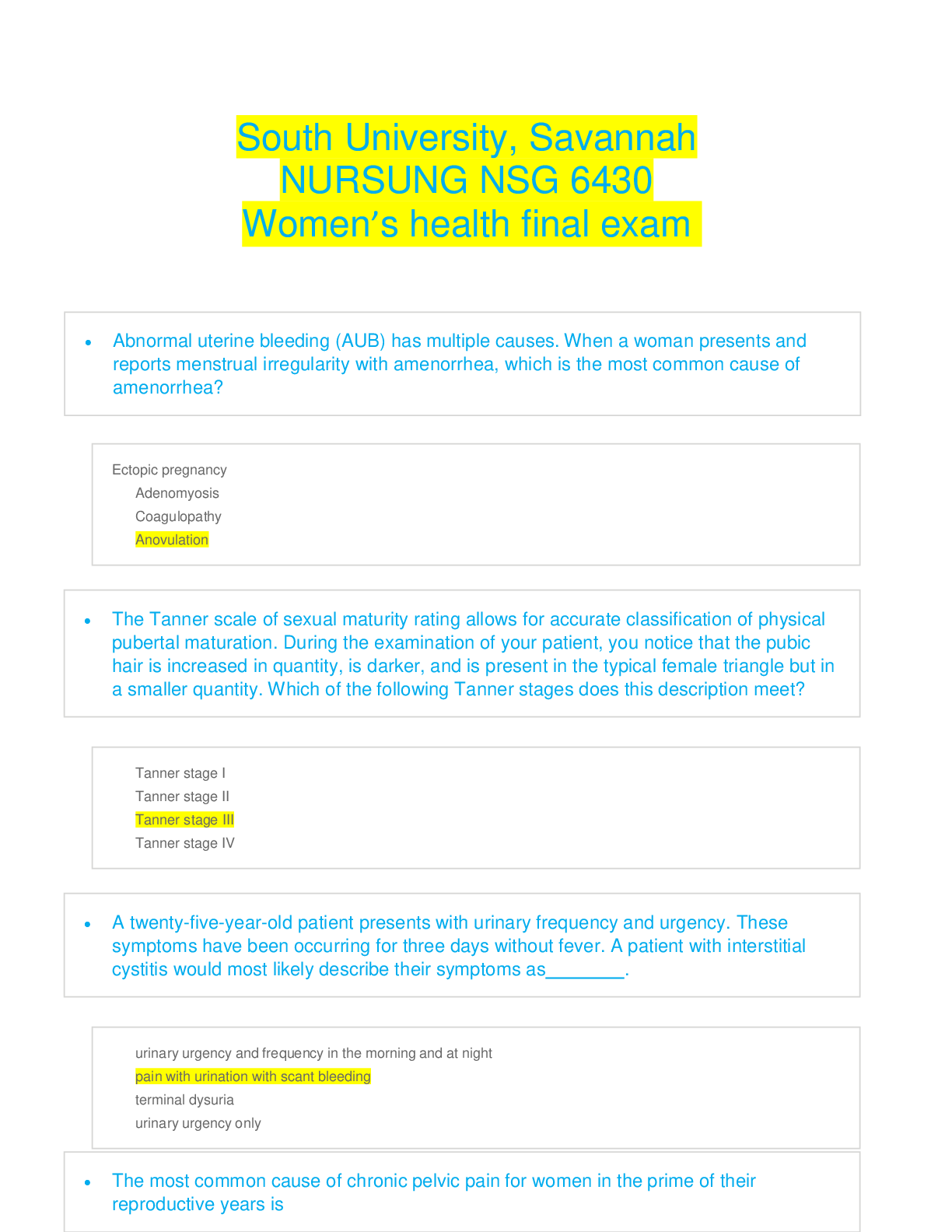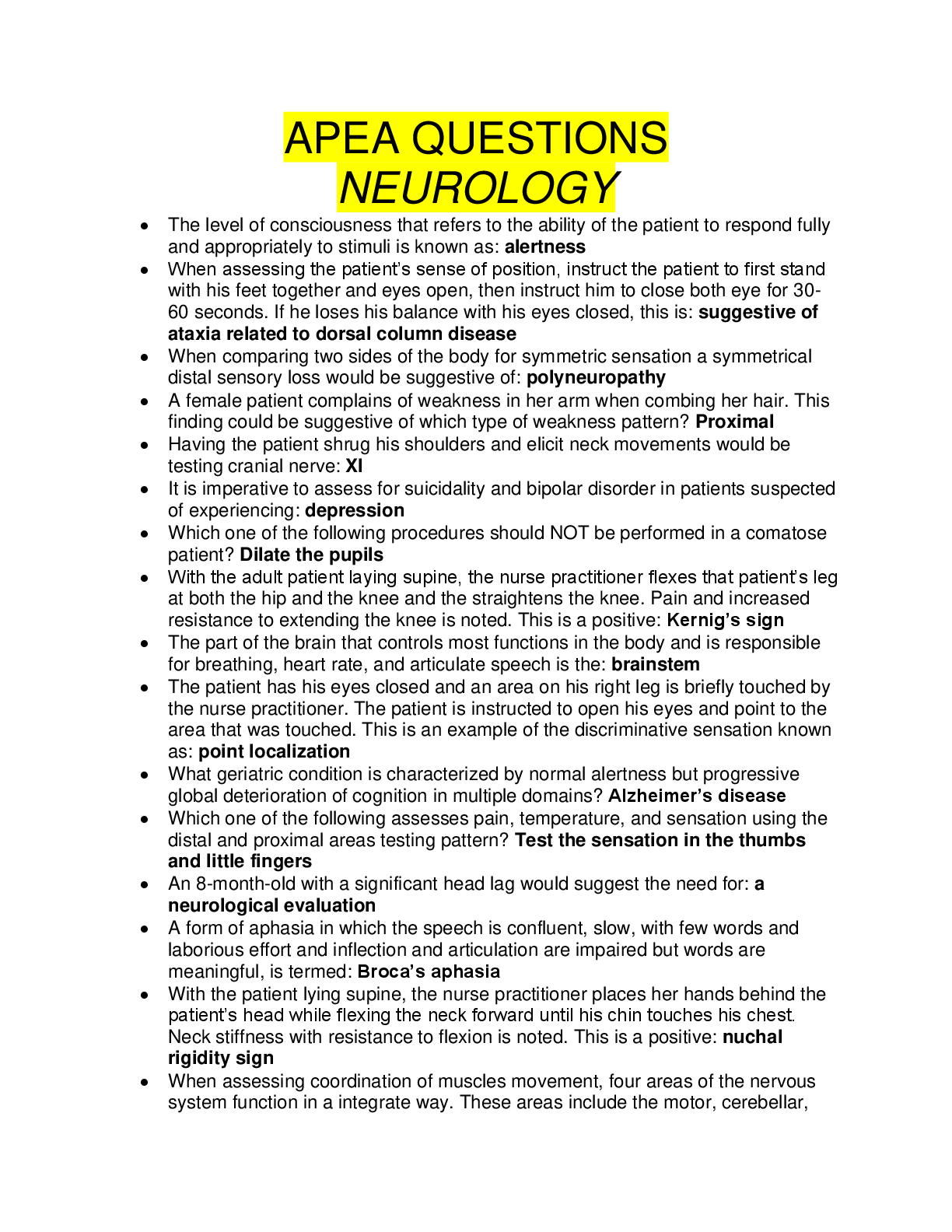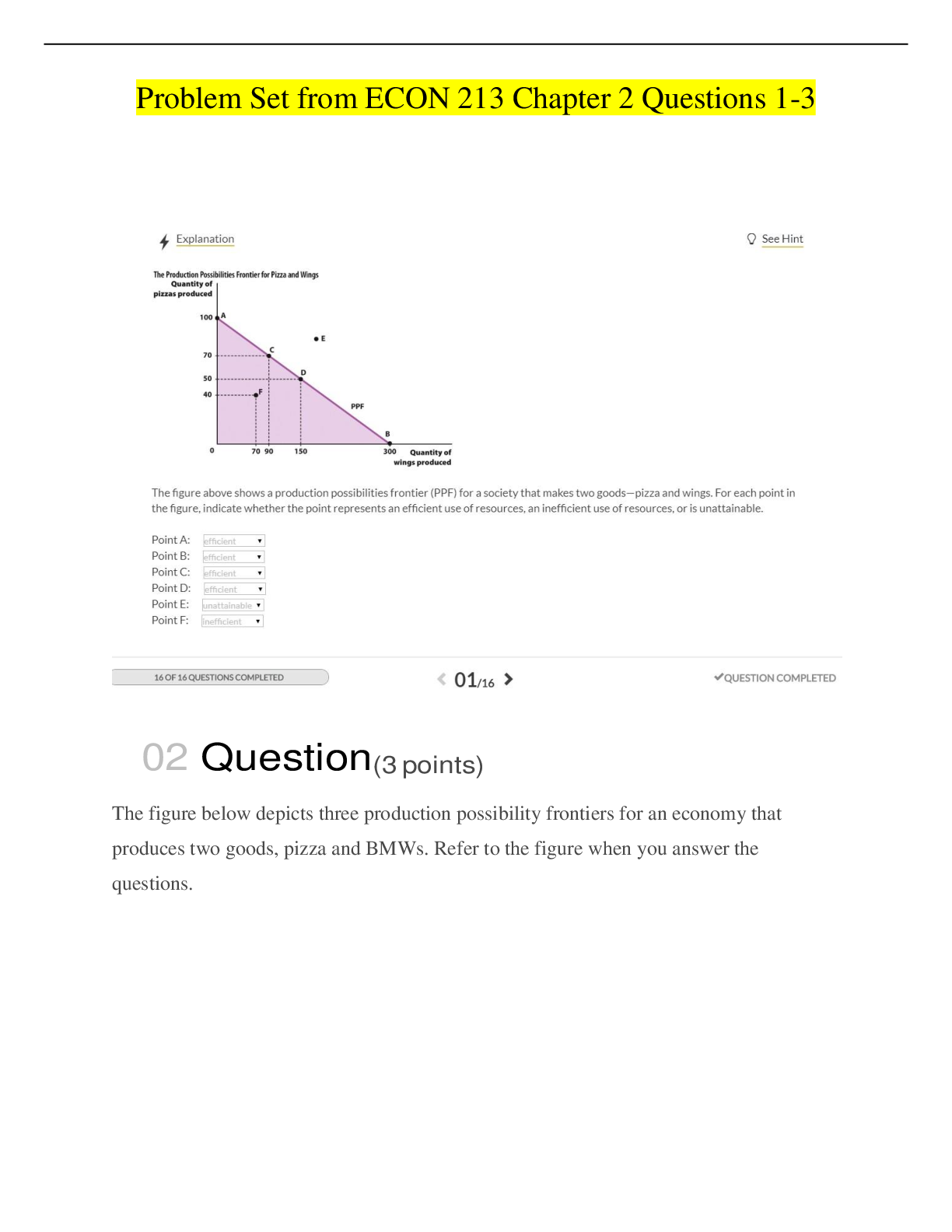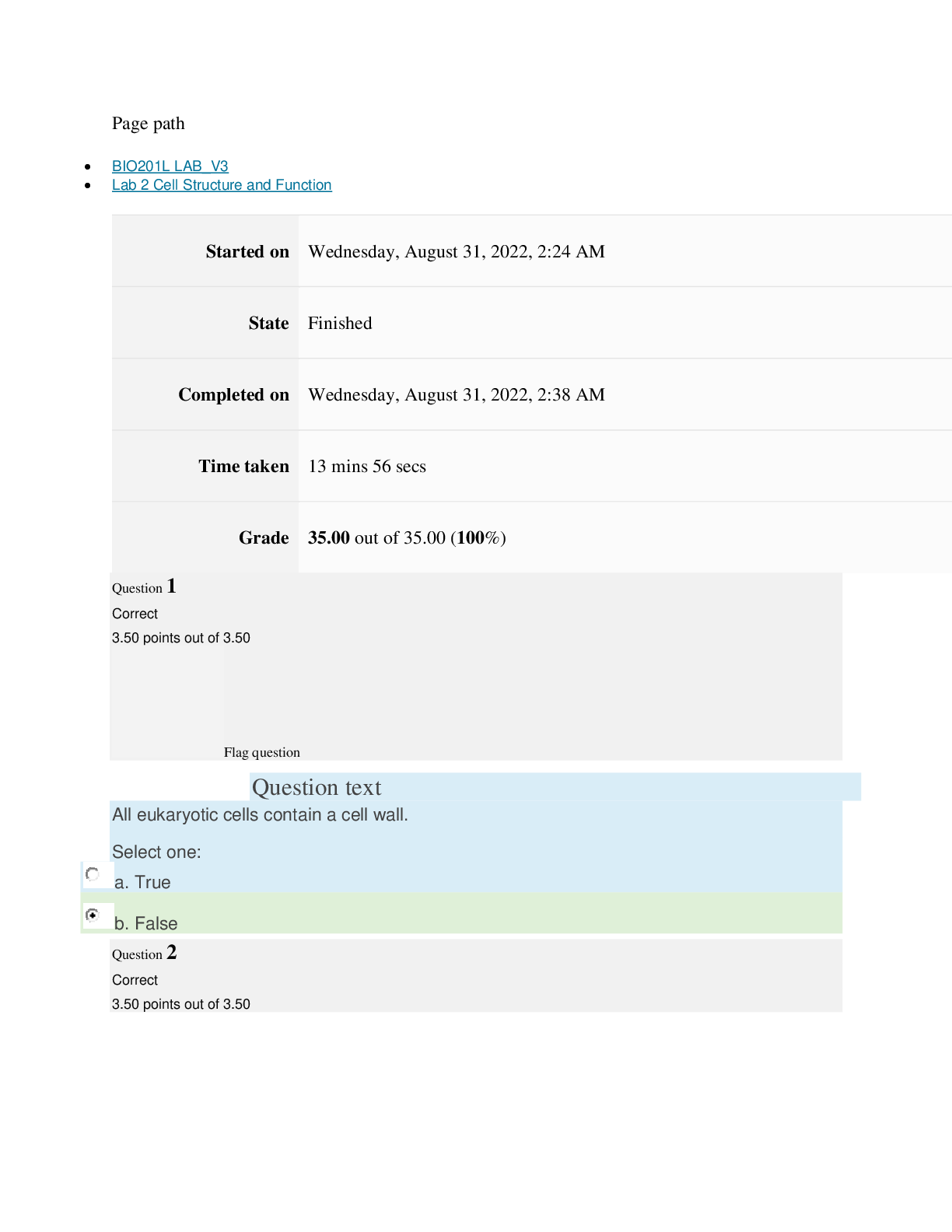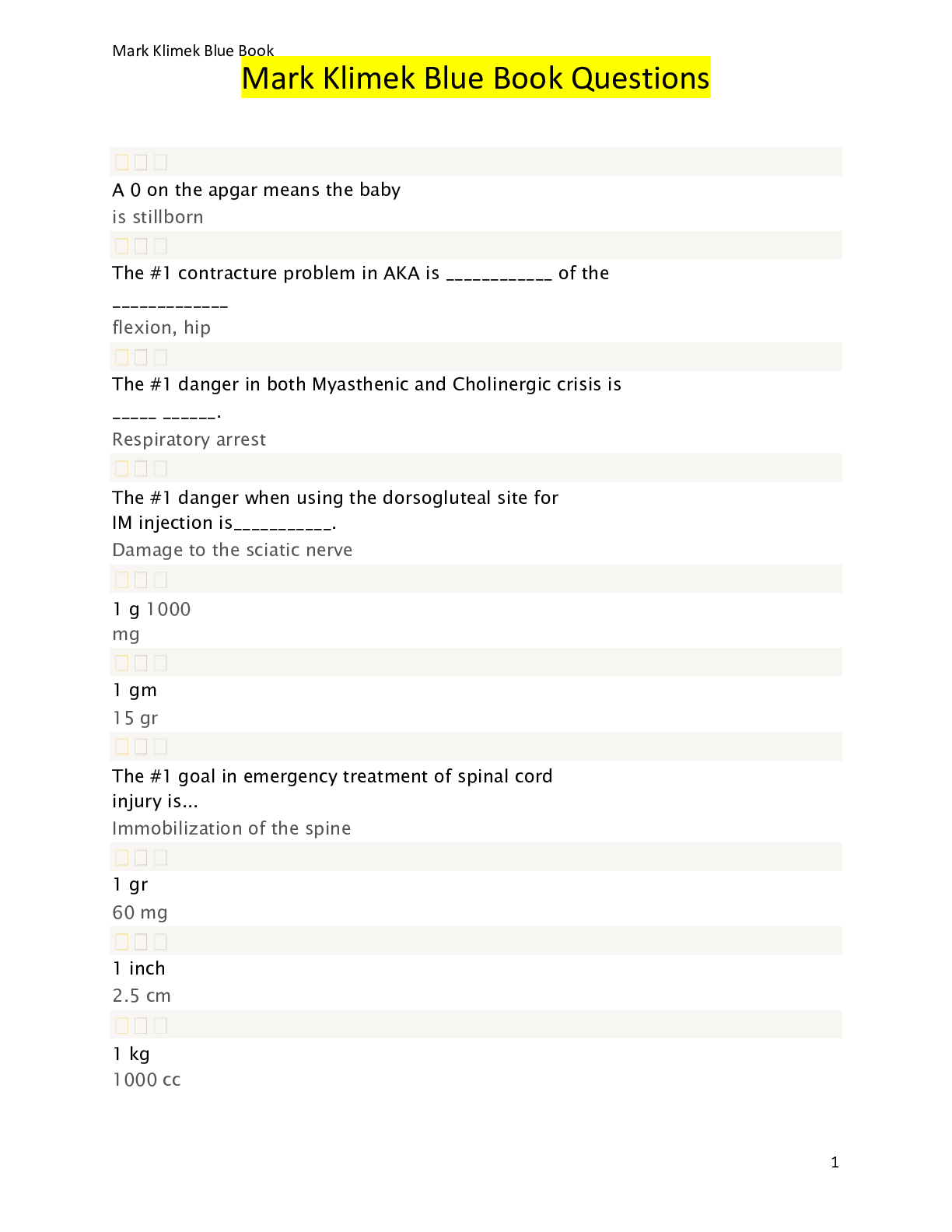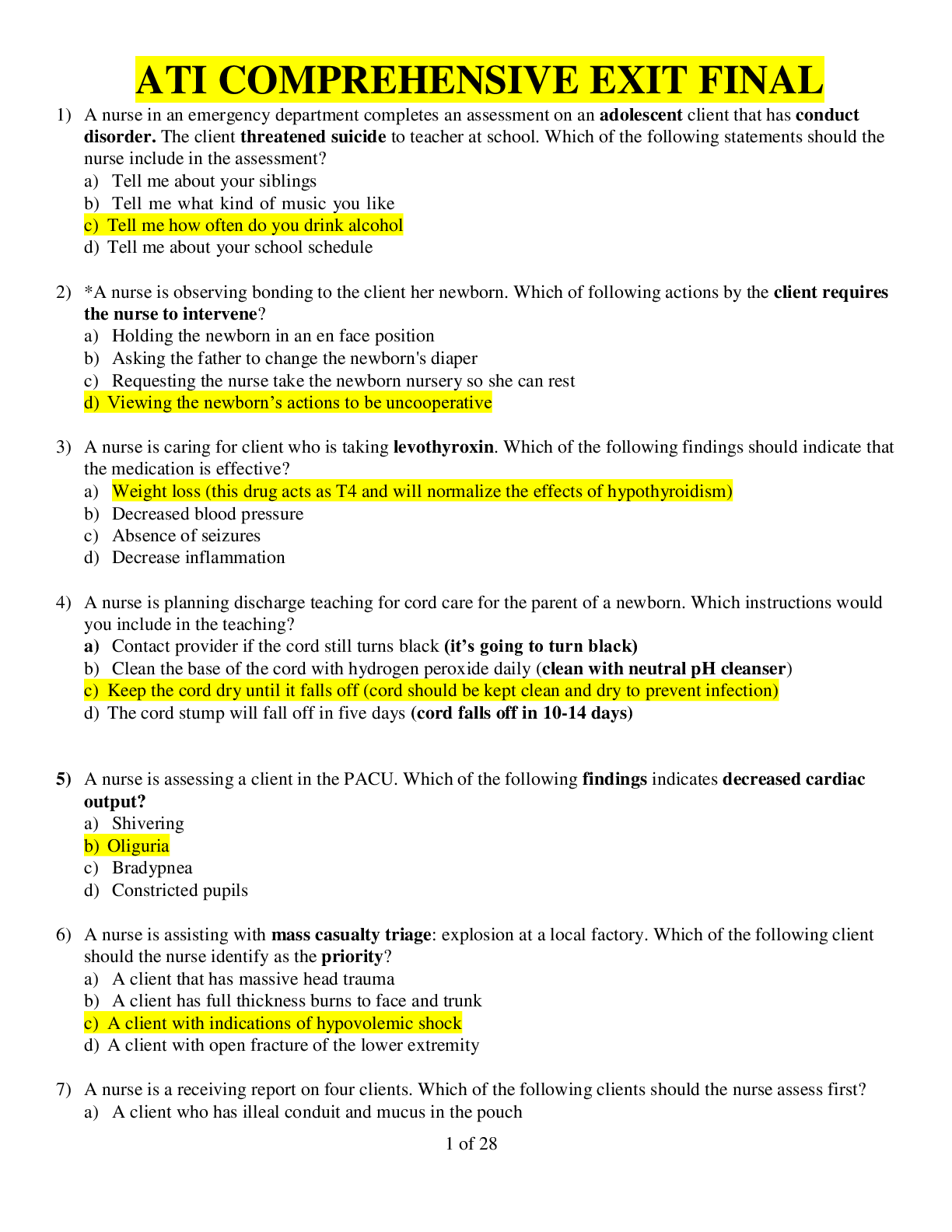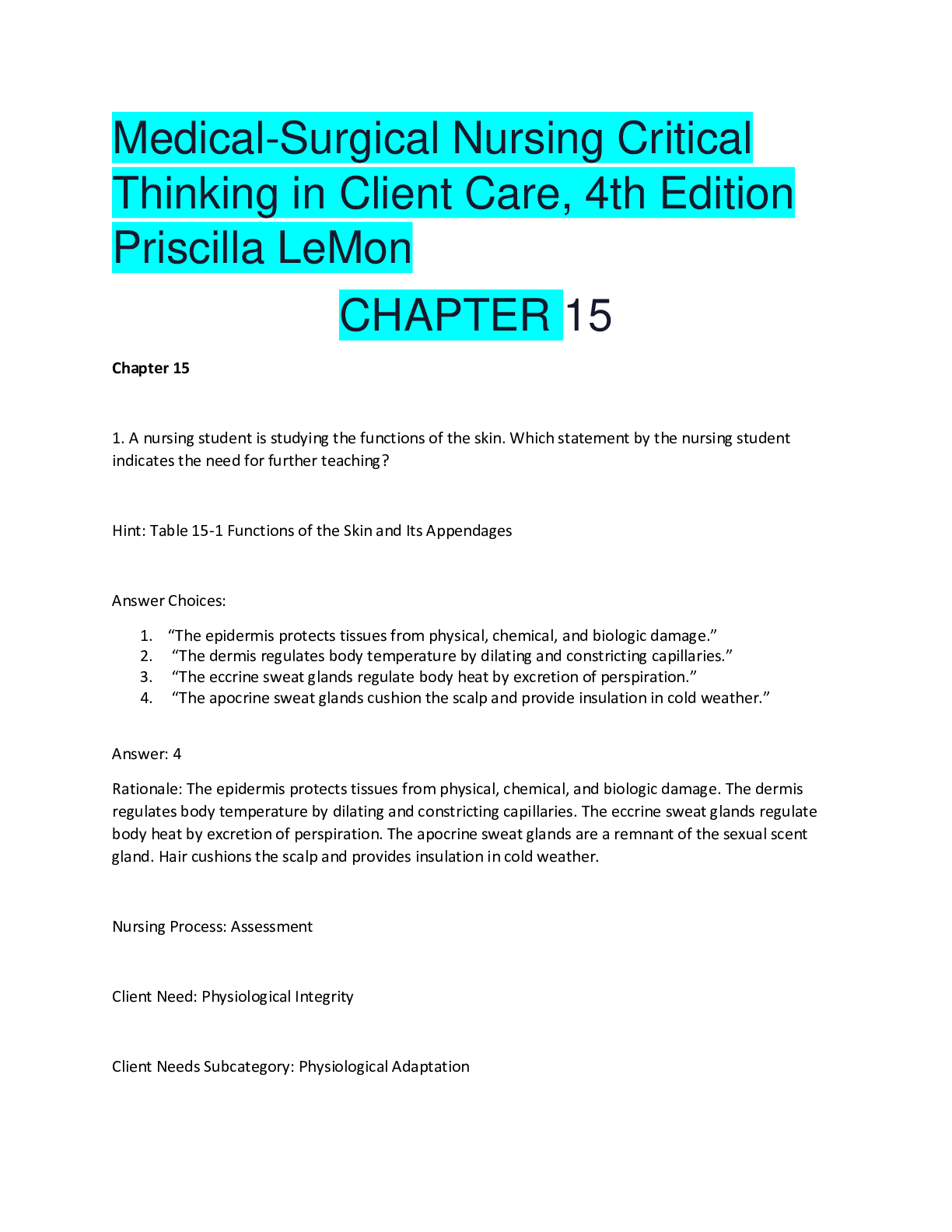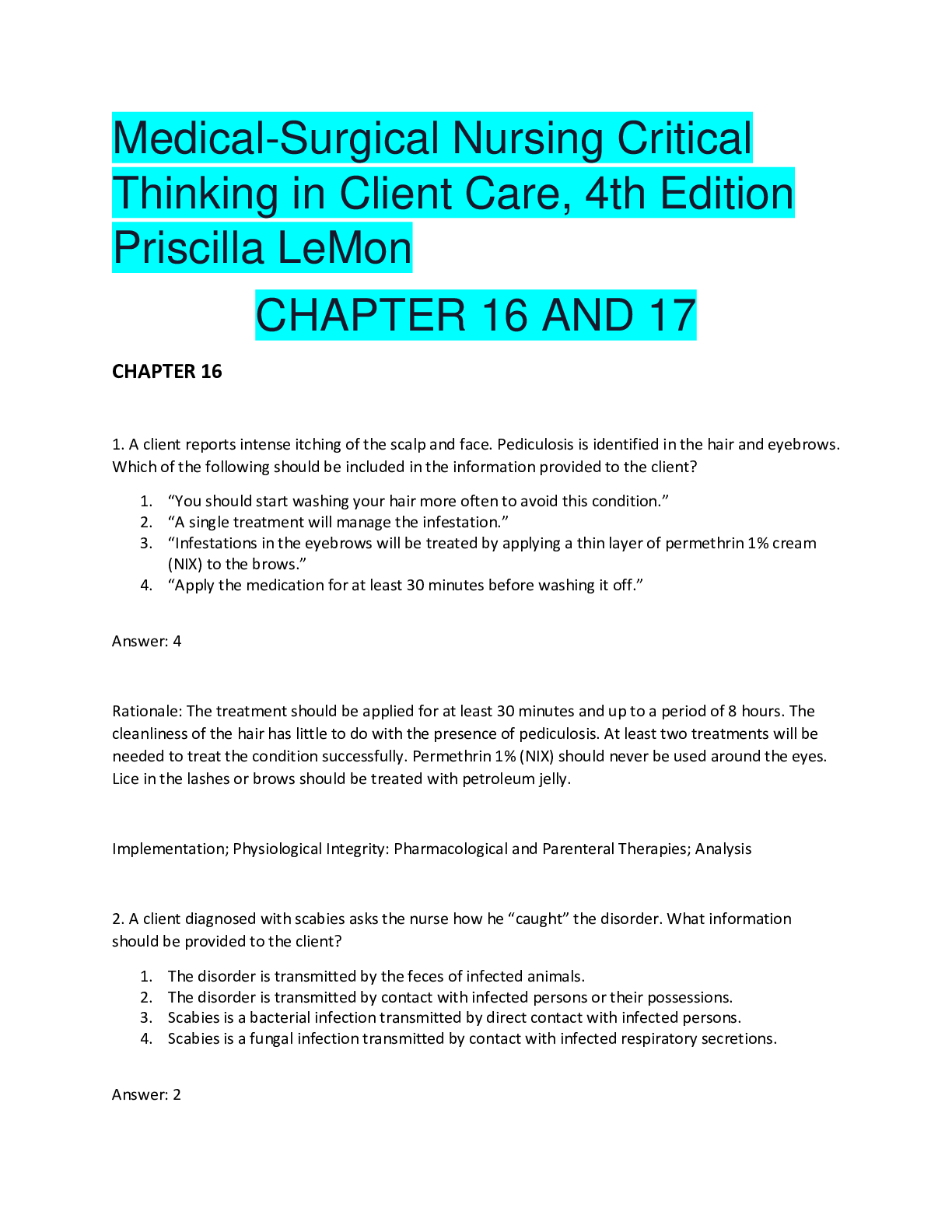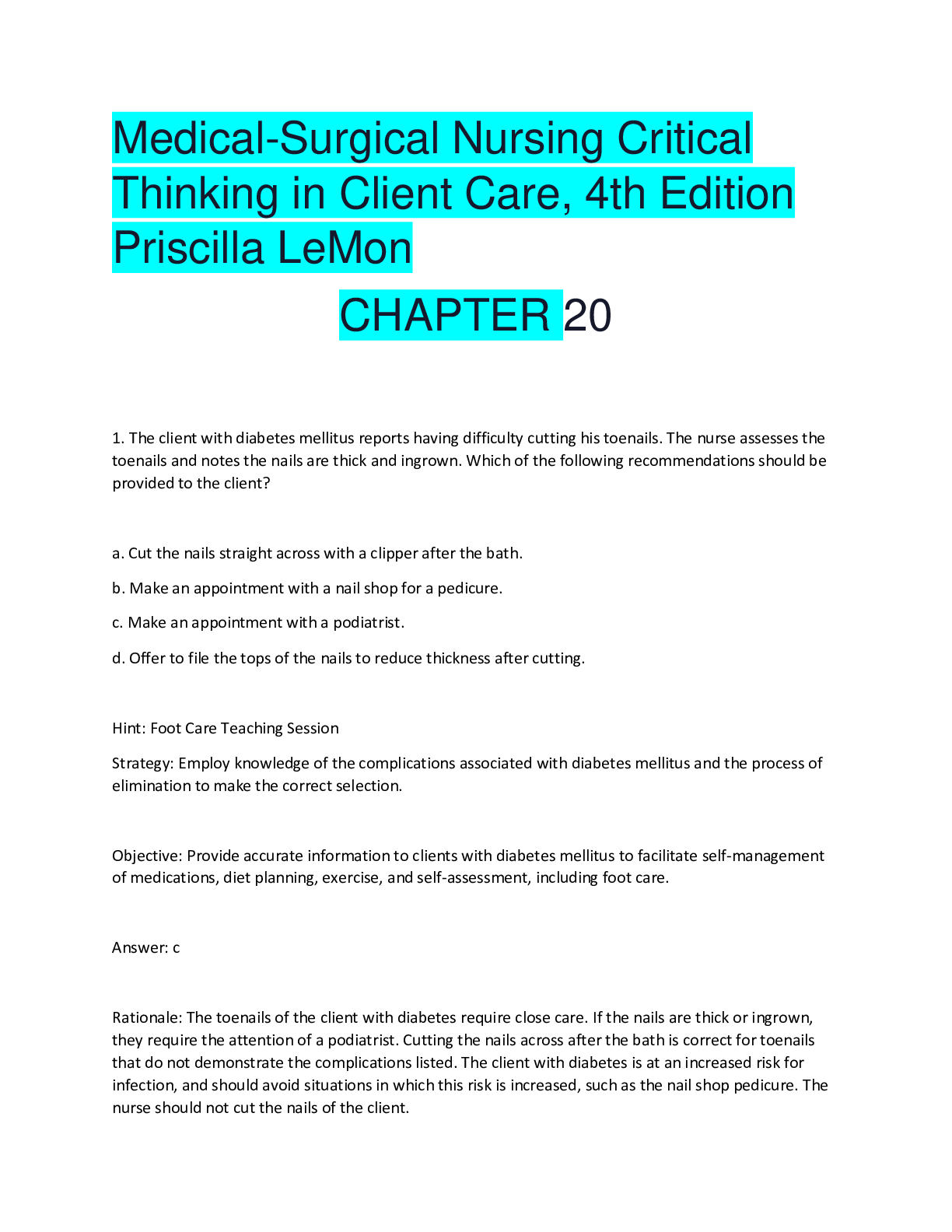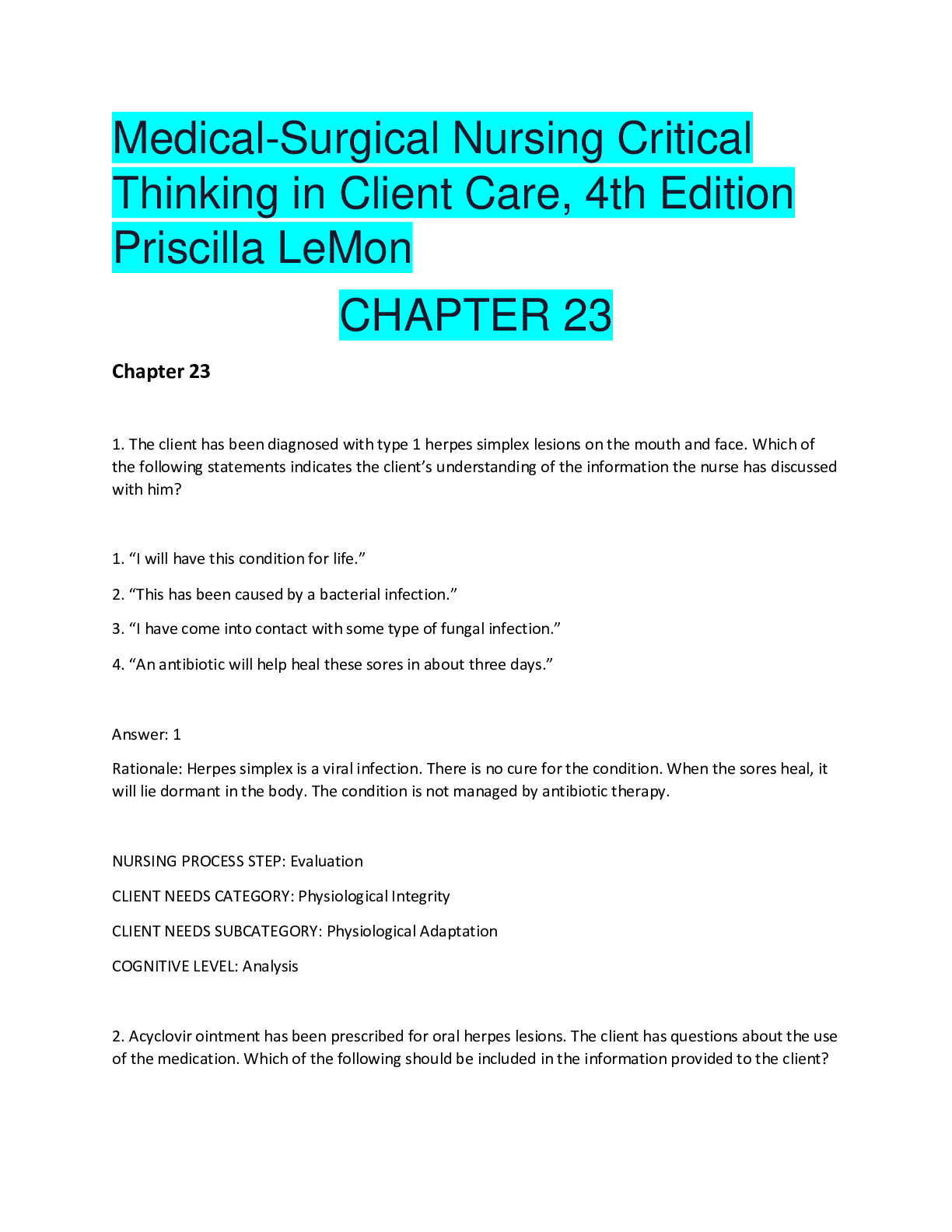Pharmacology > QUESTIONS & ANSWERS > Bevill State Community College > nursing 104. Pharmacology Quizlet > nursing 104. Pharmacology Quizl (All)
Bevill State Community College > nursing 104. Pharmacology Quizlet > nursing 104. Pharmacology Quizlet ( COMPLETE GUIDE WITH QUESTIONS, CORRECT ANSWERS AND RATIONALE)
Document Content and Description Below
Chapter 01: Drug Regulation, Actions, and Responses Workman & LaCharity: Understanding Pharmacology: Essentials for Medication Safety, 2nd Edition MULTIPLE CHOICE BASIC CONCEPTS 1. Which he... alth care professional has the major responsibility for dispensing prescribed drugs under the direction of a pharmacist? a. Physician b. Nurse practitioner c. Licensed nurse d. Pharmacy technician 2. Which term describes the effect of a drug that improves body function? a. Side effect b. Intended action c. Adverse reaction d. Idiosyncratic response 3. Which type of drug name is “owned” by the company that manufactures it? a. Generic name b. Chemical name c. Category name d. Trade name 4. Which drug or drug class is a “high alert” drug? a. Penicillin b. Insulin c. NSAIDs d. Calcium narcotics (opioids), insulin, cancer chemotherapy drugs, and heparin (or any drug that strongly affects blood clotting). Penicillin, NSAIDs, and calcium are not considered high alert drugs. DIF: Cognitive Level: Remembering REF: p. 4 5. What is the term for a drug that has the same action as a naturally occurring body hormone or enzyme? a. Agonist b. Blocking agent c. Chemical d. Duplicator 6. Which term describes how the body affects drug activity? a. Drug potency b. Pharmacodynamics c. Therapeutic effect d. Pharmacokinetics 7. In the United States, which group is responsible for enforcing established standards for drug manufacturing? a. U.S. Pharmacopeia b. National Institutes of Health c. Food and Drug Administration d. Association of Pharmaceutical Manufacturers 8. Which factor is a major disadvantage of the transdermal drug delivery route? a. Only a prescriber can administer drugs by the transdermal route. b. Transdermal drugs must be sterile rather than clean. c. First pass drug loss by this route is the most extensive. d. Drug absorption is dependent on adequate circulation. 9. How are intrinsic drugs different from extrinsic drugs? a. Intrinsic drugs are made by the body, whereas extrinsic drugs are made outside the body. b. Intrinsic drugs are administered by the parenteral route, whereas extrinsic drugs are administered by the oral route. c. Extrinsic drugs can only be applied to the skin or mucous membranes, whereas intrinsic drugs are taken internally. d. Extrinsic drugs require a prescription for administration, whereas intrinsic drugs are available over-the-counter. 10. A patient asks why his drug to control high blood pressure has only one generic name and two different trade names. What is your best response? a. “Most drugs have different trade names that indicate different dosages.” b. “The two different trade names indicate that one is a more pure and safer drug than the other.” c. “The generic name is the actual official drug name and the trade name is a brand owned by a specific manufacturer.” d. “If you have insurance, you can get the trade name drug, which is usually more expensive than the generic named drug.” DIF: Cognitive Level: Applying or Higher REF: pp. 3-4 11. How are the terms drug and medication different in the health care environment? a. Medications must be prescribed, whereas drugs are available over-the-counter. b. Medications are used to treat health problems, whereas drugs can be misused. c. Drugs are always illegal, whereas medications are legal. d. There is no difference between these two terms. 12. The prescriber tells a patient with allergies to use oral diphenhydramine (Benadryl) over-the-counter (OTC) to help manage her symptoms. She tells you that she would rather have a prescription for the “real” Benadryl because she knows it is stronger and will work better than the nonprescription form. What is your best response? a. “If you receive a prescription for this drug your name will be added to a controlled substances list.” b. “It is better to use the OTC Benadryl rather than the prescribed form because it has fewer side effects.” c. “The OTC form of Benadryl is the same strength as the one that was available by prescription only.” d. “You are correct. I will ask the health care provider to write a prescription so that you can get the most effective drug.” 13. Why is it important to always ask a patient about his or her use of any herbal supplements or botanicals? a. Many states do not have regulations about herbal supplements or botanicals. b. These substances are illegal and their use by patients must be reported. c. Patients who use botanicals seldom take their prescribed drugs. d. These substances can interact with a prescribed drug. 14. How are the effects of naturally occurring testosterone changed when a patient is taking a drug that is a testosterone agonist? a. Effects are increased. b. Effects are decreased. c. Effects are eliminated. d. Effects are unchanged. 15. Which feature of a drug agonist increases its potency? a. It is water soluble. b. It binds tighter and longer to its receptors than do other drugs. c. It is excreted through the intestinal tract rather than through the kidneys. d. It is administered intramuscularly rather than by the intravenous route. 16. Which statement about agonist and antagonist drugs is true? a. The target tissues for these types of drugs are invading bacteria and viruses. b. Both agonist and antagonist drugs must interact with receptors to produce their intended responses. c. Antagonist drugs produce only intended responses and agonist drugs produce both intended responses and side effects. d. These types of drugs are less likely to cause allergic responses than drugs that are neither agonists nor antagonists. 17. A patient asks why he must take a “loading dose” for the first dose of his prescribed drug and then take lower doses after that. What is your best response? a. “The loading dose allows the first dose of this drug to get into your bloodstream faster and because it stays in the bloodstream a long time, you can take lower doses after that.” b. “The first dose of a drug has to be higher to reach the bloodstream because the liver destroys it before it has a chance to start its action and work for you.” c. “By taking the highest dose first and just once, you are reducing the likelihood of having a bad reaction or other side effects to this drug.” d. “This schedule helps by ensuring that the drug is having an effect even if you forget to take the rest of the doses.” 18. Which action could make a drug more potent? a. Slow drug absorption b. Slow drug elimination c. Normal drug elimination d. Fast drug elimination 19. When teaching a patient about adverse drug reactions (ADRs), which precaution is most important to include? a. “Take your medications right before you go to bed so that you can sleep through an ADR.” b. “Keep a written record of the date and time an ADR occurs.” c. “Stop taking the drug and flush it down the toilet.” d. “Immediately seek medical help.” 20. A patient tells you that she is allergic to the drug her health care provider just prescribed. What is your best first response or action? a. Ask her to describe the allergic response she had previously to this drug. b. Ask her whether she received the drug she was allergic to by mouth or by injection. c. Thank her for the information and ask the health care provider to prescribe something else. d. Tell her that the health care provider will also prescribe an antidote that will prevent an allergic response to the prescribed drug. 21. How would a drug dose that is below the minimum effective concentration (MEC) affect a patient’s response to the drug? a. Drug entry exceeds drug elimination. b. The intended response fails to occur. c. The risk for toxic side effects is increased. d. The drug’s duration of action is longer than expected. 22. A patient asks why she becomes sleepy after she takes a specific drug but that her neighbor who takes the same drug at the same dose does not experience sleepiness. What is your best response? a. “Your neighbor may also be taking another drug to reduce the side effects of this drug.” b. “Your neighbor is probably addicted to this prescribed drug and you are not.” c. “Side effects are very dependent on the time of day when the drug is taken.” d. “People often experience side effects of the same drug differently.” 23. What precaution do you need to take when a patient is prescribed a drug that has a “black box warning?” a. Avoiding oral administration of this drug. b. Avoiding intravenous administration of this drug. c. Closely observing the patient for specific adverse reactions. d. Ensuring that the prescriber is present when the drug is given. 24. Morphine and hydromorphone (Dilaudid) are two types of opioid receptor agonists used for pain management. Hydromorphone is a more potent drug than morphine, and lower doses are needed to control pain. How do actions at receptor sites explain this difference? a. Morphine remains bound to opioid receptors longer than hydromorphone does. b. Hydromorphone remains bound to opioid receptors longer than morphine does. c. Morphine is metabolized and eliminated at a faster rate than hydromorphone. d. Hydromorphone is metabolized and eliminated at a faster rate than morphine. 25. Which drug administration route is the least predictable? a. Enteral b. Intravenous c. Transdermal d. Subcutaneous 26. Why is the intravenous route of drug administration route the most dangerous? a. If the needle clogs, the patient does not receive the drug. b. The intestinal tract does not detoxify these drugs. c. Drugs are immediately bioavailable. d. Drugs have extensive “first pass” loss. 27. The likelihood that a drug will sequester (be trapped) in fat cells and remain in the body longer is increased by which drug characteristic? a. Dissolves easily in water b. Dissolves easily in lipids c. Physical small size d. Physical large size DIF: Cognitive Level: Understanding (Comprehension) REF: p. 12 28. A patient has a deficiency of an enzyme that prepares a specific drug for elimination. For which response or issue should you remain alert? a. Toxic blood levels of the drug are more likely to occur. b. Higher drug dosages will be needed for the intended action to occur. c. The drug will be eliminated more rapidly in the feces rather than in the urine. d. Delivery of this drug by the parenteral route is more effective than by the enteral route. DIF: Cognitive Level: Applying or Higher REF: p. 15 29. A patient has all of the following health problems. Which problem increases his or her risk for drug side effects? a. Asthma b. Kidney disease c. GI ulcers d. Chronic high blood pressure 30. When a patient takes 400 mg of an oral drug that has a half-life of 2 hours at noon, at which time will the patient’s blood drug level first be less than 40 mg? a. 2:00 p.m. b. 6:00 p.m. c. 8:00 p.m. d. Midnight 31. When an oral drug that is not absorbed systemically is prescribed to a woman who is breastfeeding, what is the risk for harm to the infant? a. Not predicted to increase risk b. Low likelihood of increasing the risk c. Moderate likelihood of increasing the risk d. High likelihood of increasing the risk 32. A patient is prescribed a drug that has an extremely short half-life for chest pain (angina). Which modification in drug dosage or scheduling should you expect? a. Once-daily dosing b. More frequent dosing c. Larger first dose and smaller repeat doses d. Parenteral doses greater than enteral doses 33. Why are antibiotics from the tetracycline drug group seldom prescribed during pregnancy? a. Although the mother may have an infection, the fetus does not; giving these drugs to the mother would expose the fetus to unnecessary drugs. b. The pregnant woman does not metabolize tetracycline to its active form and excessively high doses are needed for an intended action. c. These drugs reduce the thickness of the enamel in developing teeth, so the infant would have darkly stained teeth. d. The fetal liver is too immature to inactivate these drugs and eliminate them; they increase the risk for severe birth defects. 34. A patient who has a serious chronic disorder (epilepsy) has been taking a drug to control it that has a moderate likelihood of increasing the risk for birth defects or fetal damage. She tells you that she would like to have a child. What is your best response? a. Tell her that taking any drug during pregnancy is not recommended. b. Suggest that she use a reliable method of contraception and consider adoption. c. Warn her that her condition will get worse if she stops taking the prescribed drug. d. Counsel her to discuss her wishes with her health care provider to evaluate her specific risks and possible pregnancy outcomes. 35. A patient with severe heart failure asks why the prescriber has lowered the dosages of most of the patient’s daily medications. What is your best response? a. “With a weaker heart, the drugs stay in your system longer, so you don’t need as high a dosage.” b. “Your heart drugs enhance the action of your other drugs, reducing the need for higher dosages.” c. “Your heart is not strong enough to tolerate these drugs, making the risk for a heart attack higher.” d. “The drugs are very expensive, and with these heart problems your health is not expected to improve.” DIF: Cognitive Level: Applying or Higher REF: pp. 19-20 36. A 25-year-old patient is prescribed a drug for acne for 6 months that is teratogenic. Which precaution is most important to teach this patient? a. “Drugs with this classification reduce the effectiveness of oral contraceptives and you will need to switch to another form of birth control to prevent pregnancy.” b. “One side effect of drugs with this classification is nausea, which will make morning sickness more severe if you become pregnant while taking this drug.” c. “Use two reliable forms of birth control during the next 6 months because drugs with this classification cause severe birth defects.” d. “Your risk for sexually transmitted diseases is increased while taking this drug and for 3 months after therapy is completed.” 37. Which precaution is most important to teach parents about giving an over-the-counter (OTC) drug to a child? a. “OTC drugs are only for adults, not children.” b. “Be sure to crush the tablets or capsules to prevent choking.” c. “Check with your pediatrician or pharmacist for the proper dosage.” d. “Only use the liquid form of the drug to make it easier to swallow.” MULTIPLE RESPONSE 1. Which body tissues or fluids are routes of drug elimination? (select all that apply) a. Bone marrow b. Heart c. Liver d. Lungs e. Ovary f. Saliva g. Tears COMPLETION BASIC CONCEPTS 1. What is the weight in pounds for an individual who weighs 70 kg? _____lb DIF: Cognitive Level: Understanding REF: p. 17 ADVANCED CONCEPTS 2. An adult patient weighing 180 lb is prescribed a drug dose of 2 mg/kg. What actual dose should you prepare for this patient? _____ mg [Show More]
Last updated: 2 years ago
Preview 1 out of 10 pages

Buy this document to get the full access instantly
Instant Download Access after purchase
Buy NowInstant download
We Accept:

Reviews( 0 )
$15.00
Can't find what you want? Try our AI powered Search
Document information
Connected school, study & course
About the document
Uploaded On
Apr 13, 2020
Number of pages
10
Written in
Additional information
This document has been written for:
Uploaded
Apr 13, 2020
Downloads
0
Views
92

